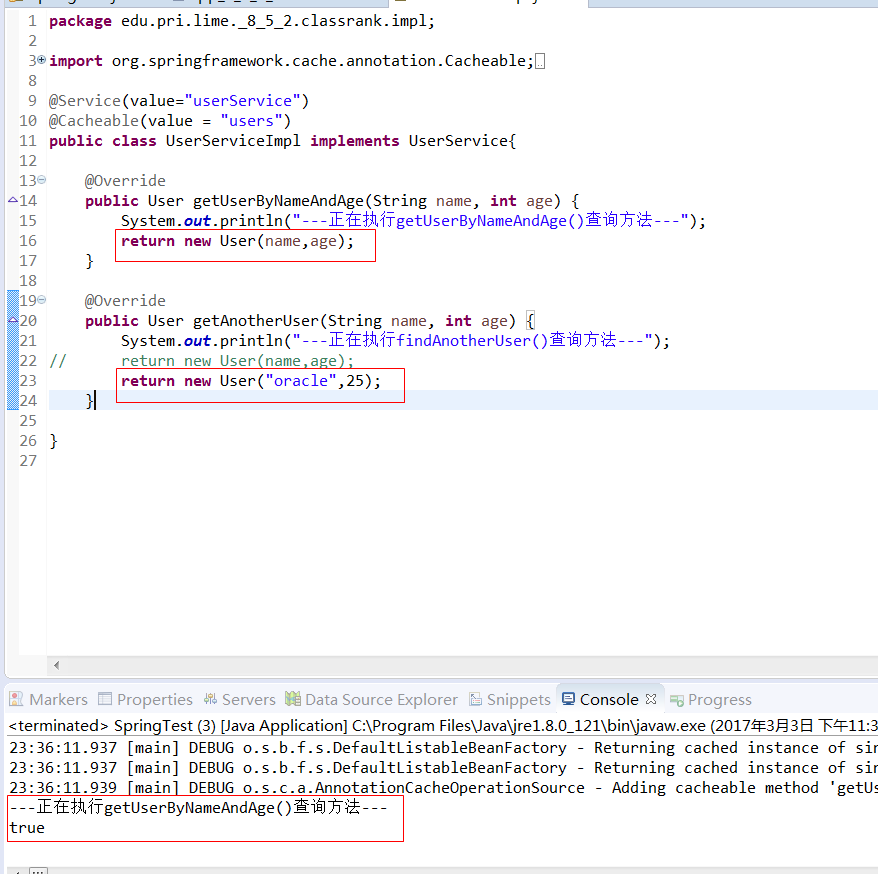8 -- 深入使用Spring -- 5...2 使用@Cacheable执行缓存
8.5.2 使用@Cacheable执行缓存
@Cacheable可用于修饰类或修饰方法,当使用@Cacheable修饰类时,用于告诉Spring在类级别上进行缓存 ------ 程序调用该类的实例的任何方法时都需要缓存,而且共享同一个缓存区;当使用@Cacheable修饰方法时,用于告诉Spring在方法级别上进行缓存 ------ 只有当程序调用该方法时才需要缓存。
1. 类级别的缓存
当使用@Cacheable修饰类时,就可控制Spring在类级别进行缓存,这样程序调用类的任意方法时,只要传入的参数相同,Spring就会使用缓存。
Component : UserServiceImpl
package edu.pri.lime._8_5_2.classrank.impl; import org.springframework.cache.annotation.Cacheable;
import org.springframework.stereotype.Service; import edu.pri.lime._8_5_2.classrank.UserService;
import edu.pri.lime._8_5_2.classrank.bean.User; @Service(value="userService")
@Cacheable(value = "users")
public class UserServiceImpl implements UserService{ @Override
public User getUserByNameAndAge(String name, int age) {
System.out.println("---正在执行getUserByNameAndAge()查询方法---");
return new User(name,age);
} @Override
public User getAnotherUser(String name, int age) {
System.out.println("---正在执行findAnotherUser()查询方法---");
return new User(name,age);
} }
app_8_5_2_ehcache.xml:不成功,请使用SimpleCacheManager作为缓存管理器
<?xml version="1.0" encoding="UTF-8"?>
<!-- Spring 配置文件的根元素,使用Spring-beans-4.0.xsd语义约束 -->
<beans xmlns:xsi="http://www.w3.org/2001/XMLSchema-instance"
xmlns="http://www.springframework.org/schema/beans" xmlns:context="http://www.springframework.org/schema/context"
xmlns:cache="http://www.springframework.org/schema/cache" xmlns:aop="http://www.springframework.org/schema/aop"
xmlns:P="http://www.springframework.org/schema/p"
xsi:schemaLocation="http://www.springframework.org/schema/beans
http://www.springframework.org/schema/beans/spring-beans-4.0.xsd
http://www.springframework.org/schema/aop
http://www.springframework.org/schema/aop/spring-aop-4.0.xsd
http://www.springframework.org/schema/cache
http://www.springframework.org/schema/cache/spring-cache-4.0.xsd
http://www.springframework.org/schema/context
http://www.springframework.org/schema/context/spring-context-4.0.xsd"> <context:component-scan base-package="edu.pri.lime._8_5_2.classrank">
</context:component-scan> <cache:annotation-driven cache-manager="cacheManager" /> <bean id="cacheManager" class="org.springframework.cache.support.SimpleCacheManager">
<property name="caches">
<set>
<bean
class="org.springframework.cache.concurrent.ConcurrentMapCacheFactoryBean">
<property name="name" value="default" />
</bean>
<bean
class="org.springframework.cache.concurrent.ConcurrentMapCacheFactoryBean">
<property name="name" value="users" />
</bean> </set>
</property>
</bean> <!--
<bean id="ehCacheManager" class="org.springframework.cache.ehcache.EhCacheManagerFactoryBean">
<property name="configLocation" value="classpath:app_8_5_2_ehcache.xml"/>
<property name="shared" value="false"/>
</bean>
<bean id="cacheManager" class="org.springframework.cache.ehcache.EhCacheCacheManager">
<property name="cacheManager" ref="ehCacheManager"/>
</bean> --> </beans>
Class : SpringTest
package edu.pri.lime._8_5_2.classrank.impl; import org.springframework.context.ApplicationContext;
import org.springframework.context.support.ClassPathXmlApplicationContext; import edu.pri.lime._8_5_2.classrank.UserService;
import edu.pri.lime._8_5_2.classrank.bean.User; public class SpringTest { public static void main(String[] args) {
ApplicationContext ctx = new ClassPathXmlApplicationContext("app_8_5_2_classrank.xml");
UserService userService = (UserService) ctx.getBean("userService");
User userA = userService.getUserByNameAndAge("lime", 24);
User userB = userService.getAnotherUser("lime", 24);
System.out.println(userA == userB);
}
}
Console :
---正在执行getUserByNameAndAge()查询方法---
true
@Cacheable(value="users")指定UserServiceImple进行类级别的缓存,这样程序调用该类的任意方法时,只要传入的参数相同,Spring就会使用缓存,即时方法的返回值并不真正的同一个对象。

此处所指的缓存的意义是:当程序第一次调用该类的实例的某个方法时,Spring缓存机制会将该方法返回的数据放入指定缓存区 ------ 就是@Cacheable注解的value属性所指定的缓存区(此处指定将数据放入users缓存区,正是缓存管理器配置的users缓存区)。以后程序调用该类的实例的任何方法时,只要出入的参数相同,Spring将不会真正执行该方法,而是直接利用缓存区中的数据。
类级别的缓存默认以所有方法参数作为key来缓存方法返回的数据 ------ 同一类不管调用哪个方法,只要调用方法时传入的参数相同,Spring都会直接利用缓存区中的数据。
使用@Cacheable时可指定如下属性:
⊙ value : 必需属性。该属性可指定多个缓存区的名字,用于指定将方法返回值放入指定的缓存区内。
⊙ key : 通过SpEL表达式显式指定缓存的key。多个参数组合的key 用#name + #age + ...
⊙ condition : 该属性指定一个返回boolean值的SpEL表达式,只有当该表达式返回true时,Spring才会缓存方法返回值。
⊙ unless : 该属性指定一个返回boolean值的SpEL表达式,当该表达式返回true时,Spring就不缓存方法返回值。
提示:
与@Cacheable注解功能类似的还有一个@CachePut注解,@CachePut注解同样会让Spring将方法返回值放入缓存区。与@Cacheable不同的是,@CachePut修饰的方法不会读取缓存区中的数据 ------ 这意味着不管缓存区是否已有数据,@CachePut总会告诉Spring要重新执行这些方法,并再次将方法返回值放入缓存区。
修改UserServiceImpl : @Cacheable(value = “users” , key = “#name”) 显式指定以name参数作为缓存的key,这样只要调用的方法具有相同的name参数,Spring缓存机制就会生效。
package edu.pri.lime._8_5_2.classrank.service.cacheablekey.main; import org.springframework.context.ApplicationContext;
import org.springframework.context.support.ClassPathXmlApplicationContext; import edu.pri.lime._8_5_2.classrank.bean.User;
import edu.pri.lime._8_5_2.classrank.service.cacheable.UserService; public class SpringTest { public static void main(String[] args) {
ApplicationContext ctx = new ClassPathXmlApplicationContext("app_8_5_2_classrankkey.xml");
UserService userService = (UserService) ctx.getBean("userService");
User userA = userService.getUserByNameAndAge("lime", 22);
User userB = userService.getAnotherUser("lime", 24);
System.out.println(userA == userB); }
}
Console :
---正在执行getUserByNameAndAge()查询方法---
true
使用@Cacheable注解显式指定key = “#name” ,这就意味着缓存使用name参数作为缓存的key。
condition属性与unless属性的功能基本相似,但规则恰好相反:当condition指定的条件为true时,Spring缓存机制才会执行缓存;当unless指定的条件为true时,Spring缓存机制就不执行缓存。
Class : UserServiceImpl
package edu.pri.lime._8_5_2.classrank.service.cacheablecondition.impl; import org.springframework.cache.annotation.Cacheable;
import org.springframework.stereotype.Service; import edu.pri.lime._8_5_2.classrank.bean.User;
import edu.pri.lime._8_5_2.classrank.service.cacheablecondition.UserService; @Service("userService")
@Cacheable(value="users" ,condition="#age<100")
public class UserServiceImpl implements UserService{ @Override
public User getUserByNameAndAge(String name, int age) {
System.out.println("---正在执行getUserByNameAndAge()查询方法---");
return new User(name,age);
} @Override
public User getAnotherUser(String name, int age) {
System.out.println("---正在执行getAnotherUser()查询方法---");
return new User("oracle",25);
} }
XML :
<?xml version="1.0" encoding="UTF-8"?>
<!-- Spring 配置文件的根元素,使用Spring-beans-4.0.xsd语义约束 -->
<beans xmlns:xsi="http://www.w3.org/2001/XMLSchema-instance"
xmlns="http://www.springframework.org/schema/beans" xmlns:context="http://www.springframework.org/schema/context"
xmlns:cache="http://www.springframework.org/schema/cache" xmlns:aop="http://www.springframework.org/schema/aop"
xmlns:P="http://www.springframework.org/schema/p"
xsi:schemaLocation="http://www.springframework.org/schema/beans
http://www.springframework.org/schema/beans/spring-beans-4.0.xsd
http://www.springframework.org/schema/aop
http://www.springframework.org/schema/aop/spring-aop-4.0.xsd
http://www.springframework.org/schema/cache
http://www.springframework.org/schema/cache/spring-cache-4.0.xsd
http://www.springframework.org/schema/context
http://www.springframework.org/schema/context/spring-context-4.0.xsd"> <context:component-scan base-package="edu.pri.lime._8_5_2.classrank.service.cacheablecondition.impl">
</context:component-scan> <!-- 启用Spring缓存 -->
<cache:annotation-driven cache-manager="cacheManager" /> <!-- 使用simpleCacheManager缓存管理器 -->
<bean id="cacheManager" class="org.springframework.cache.support.SimpleCacheManager">
<!-- 配置缓存区 -->
<property name="caches">
<set>
<!-- 使用ConcurrentMapCacheFactoryBean工程Bean生产缓存区 -->
<bean
class="org.springframework.cache.concurrent.ConcurrentMapCacheFactoryBean">
<!-- 定义缓存区名称 -->
<property name="name" value="default" />
</bean>
<bean
class="org.springframework.cache.concurrent.ConcurrentMapCacheFactoryBean">
<!-- 定义缓存区名称 -->
<property name="name" value="users" />
</bean> </set>
</property>
</bean> </beans>
Console :
---正在执行getUserByNameAndAge()查询方法---
---正在执行getAnotherUser()查询方法---
false
---正在执行getUserByNameAndAge()查询方法---
---正在执行getAnotherUser()查询方法---
false
---正在执行getUserByNameAndAge()查询方法---
---正在执行getAnotherUser()查询方法---
false
疑惑 : 跟想象中的不一样啊! 说好的condition表达式呢?
使用@Cacheable修饰方法时,可控制Spring在方法级别进行缓存,这样当程序调用该方法时,只要传入的参数相同,Spring就会使用缓存。
2.方法级别的缓存
Class : UserServiceImpl
package edu.pri.lime._8_5_2.functionrank.service.impl; import org.springframework.cache.annotation.Cacheable;
import org.springframework.stereotype.Service; import edu.pri.lime._8_5_2.functionrank.bean.User;
import edu.pri.lime._8_5_2.functionrank.service.UserService; @Service("userService")
public class UserServiceImpl implements UserService{ @Override
@Cacheable(value="userA")
public User getUserByNameAndAge(String name, int age) {
System.out.println("---正在执行getUserByNameAndAge()查询方法---");
return new User(name,age);
} @Override
@Cacheable(value="userB")
public User getAnotherUser(String name, int age) {
System.out.println("---正在执行findAnotherUser()查询方法---");
return new User("oracle",25);
} }
XML : app_8_5_2_functionrankvalue.xml
<?xml version="1.0" encoding="UTF-8"?>
<!-- Spring 配置文件的根元素,使用Spring-beans-4.0.xsd语义约束 -->
<beans xmlns:xsi="http://www.w3.org/2001/XMLSchema-instance"
xmlns="http://www.springframework.org/schema/beans" xmlns:context="http://www.springframework.org/schema/context"
xmlns:cache="http://www.springframework.org/schema/cache" xmlns:aop="http://www.springframework.org/schema/aop"
xmlns:P="http://www.springframework.org/schema/p"
xsi:schemaLocation="http://www.springframework.org/schema/beans
http://www.springframework.org/schema/beans/spring-beans-4.0.xsd
http://www.springframework.org/schema/aop
http://www.springframework.org/schema/aop/spring-aop-4.0.xsd
http://www.springframework.org/schema/cache
http://www.springframework.org/schema/cache/spring-cache-4.0.xsd
http://www.springframework.org/schema/context
http://www.springframework.org/schema/context/spring-context-4.0.xsd"> <!-- 扫描Spring的组件 -->
<context:component-scan base-package="edu.pri.lime._8_5_2.functionrank.service.impl"/> <!-- 启用Spring缓存 -->
<cache:annotation-driven cache-manager="cacheManager" /> <!-- 使用simpleCacheManager缓存管理器 -->
<bean id="cacheManager" class="org.springframework.cache.support.SimpleCacheManager">
<!-- 配置缓存区 -->
<property name="caches">
<set>
<!-- 使用ConcurrentMapCacheFactoryBean工程Bean生产缓存区 -->
<bean
class="org.springframework.cache.concurrent.ConcurrentMapCacheFactoryBean">
<!-- 定义缓存区名称 -->
<property name="name" value="userA" />
</bean>
<bean
class="org.springframework.cache.concurrent.ConcurrentMapCacheFactoryBean">
<!-- 定义缓存区名称 -->
<property name="name" value="userB" />
</bean>
</set>
</property>
</bean>
</beans>
Class : SpringTest
package edu.pri.lime._8_5_2.functionrank; import org.springframework.context.ApplicationContext;
import org.springframework.context.support.ClassPathXmlApplicationContext; import edu.pri.lime._8_5_2.functionrank.bean.User;
import edu.pri.lime._8_5_2.functionrank.service.UserService; public class SpringTest { public static void main(String[] args) {
ApplicationContext ctx = new ClassPathXmlApplicationContext("app_8_5_2_functionrankvalue.xml");
UserService userService = ctx.getBean("userService",UserService.class);
User userA = userService.getUserByNameAndAge("lime", 24);
User userB = userService.getAnotherUser("lime", 24);
System.out.println(userA == userB);
User userC = userService.getUserByNameAndAge("lime", 24);
User userD = userService.getAnotherUser("lime", 24);
System.out.println(userA == userC); }
}
Console :
---正在执行getUserByNameAndAge()查询方法---
---正在执行findAnotherUser()查询方法---
false
true
方法级别的缓存中,方法之间使用不同的缓存区,因此它们不能共享缓存。
啦啦啦
啦啦啦
啦啦啦
啦啦啦
8 -- 深入使用Spring -- 5...2 使用@Cacheable执行缓存的更多相关文章
- Spring Boot中使用EhCache实现缓存支持
SpringBoot提供数据缓存功能的支持,提供了一系列的自动化配置,使我们可以非常方便的使用缓存.,相信非常多人已经用过cache了.因为数据库的IO瓶颈.一般情况下我们都会引入非常多的缓存策略, ...
- 【快学SpringBoot】Spring Cache+Redis实现高可用缓存解决方案
前言 之前已经写过一篇文章介绍SpringBoot整合Spring Cache,SpringBoot默认使用的是ConcurrentMapCacheManager,在实际项目中,我们需要一个高可用的. ...
- spring boot:使用spring cache+caffeine做进程内缓存(本地缓存)(spring boot 2.3.1)
一,为什么要使用caffeine做本地缓存? 1,spring boot默认集成的进程内缓存在1.x时代是guava cache 在2.x时代更新成了caffeine, 功能上差别不大,但后者在性能上 ...
- 当spring 容器初始化完成后执行某个方法
在做web项目开发中,尤其是企业级应用开发的时候,往往会在工程启动的时候做许多的前置检查. 比如检查是否使用了我们组禁止使用的Mysql的group_concat函数,如果使用了项目就不能启动,并指出 ...
- Spring Web MVC中的页面缓存支持 ——跟我学SpringMVC系列
Spring Web MVC中的页面缓存支持 ——跟我学SpringMVC系列
- 在Spring、Hibernate中使用Ehcache缓存(2)
这里将介绍在Hibernate中使用查询缓存.一级缓存.二级缓存,整合Spring在HibernateTemplate中使用查询缓存.,这里是hibernate3,使用hibernate4类似,不过不 ...
- spring boot整合reids 然后实现缓存分页(方法之一) 以及RedisTemplate存到reids 里面get 就消失的坑
业务需求 首页 实现缓存分页 spring boot 整合redis (我的是2.0.3版本的) 在pom 文件写上依赖包即可 <dependency><!--依赖包--> ...
- Spring + MySQL + Mybatis + Redis【二级缓存】执行流程分析
一级缓存基于 PerpetualCache 的 HashMap 本地缓存,其存储作用域为 Session,当 Session flush 或 close 之后,该Session中的所有 Cache 就 ...
- (转)为Spring集成的Hibernate配置二级缓存
http://blog.csdn.net/yerenyuan_pku/article/details/52896195 前面我们已经集成了Spring4.2.5+Hibernate4.3.11+Str ...
随机推荐
- vs配置TFS
- json与xml数据输出类
class Response { /** * 按json方式输出通信数据 * @param integer $code 状态码 * @param string $message 提示信息 * @par ...
- 体验jQuery和AngularJS的不同点以及AngularJS的迷人之处
本篇通过jQuery和Angular两种方式来实现同一个实例,从而体验两者的不同点以及AngularJS的迷人之处. 首先当然需要引用jquery.js和angular.js文件. ■ 使用jQuer ...
- C#高级编程----反射的小结
C#反射的应用小结 1.何谓反射? 反射就是在运行的时候发现对象的相关信息.根据这些信息可以动态的执行对象的方法以及获取对象的属性所存储的值.使用.NET编写的代码时自动反射的,或者说是自我描述的.之 ...
- 微信小程序页面带参数跳转及接收参数内容navigator
功能从index页面跳转到draw页面,并在draw页面获取id及imgUrl index.wxml <navigator class='looks-view' wx:for="{{i ...
- JavaScript变量作用域(Variable Scope)和闭包(closure)的基础知识
在这篇文章中,我会试图讲解JavaScript变量的作用域和声明提升,以及许多隐隐藏的陷阱.为了确保我们不会碰到不可预见的问题,我们必须真正理解这些概念. 基本定义 作用范围是个“木桶”,里面装着变量 ...
- chrome 浏览器的插件权限有多大?
转自:https://segmentfault.com/q/1010000003777353 1)Chrome插件本身有机制控制,不会无限制的开放很多权限给你2)页面的DOM元素时可以操作的,Chro ...
- 权威公布:彻底搞清楚哪些笔记本和台式机主板能够支持42mm SATA M.2 NGFF(2242)接口的固态硬盘!!!
在京东,天猫上搜寻半天.致电联想客服以及各个固态盘的店小二.都搞不清楚兼容性问题.并且联想客服的回答明显错误,官网描写叙述也错误,客服project师也含糊不清说:要拆机试一试才知道是否兼容. 我就不 ...
- 20151028整理罗列某种开发所包括对技术(技术栈),“较为全面”地表述各种技术大系的图表:系统开发技术栈图、Web前端技术栈图、数据库技术栈图、.NET技术栈图
———————————— 我的软件开发生涯 (10年开发经验总结和爆栈人生) 爆栈人生 现在流行说全栈.每种开发都有其相关的技术.您是否觉得难以罗列某种开发所包括对技术(技术栈)呢? 您是否想过: ...
- Swift 命令行输入输出
1.类输出 Swift 语言中类输出方法重写 override var description: String { return String(format: "%@, %@", ...
